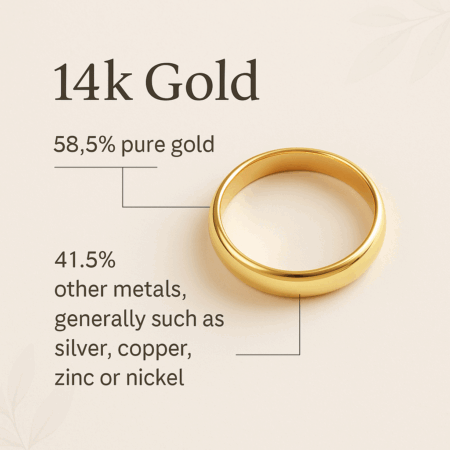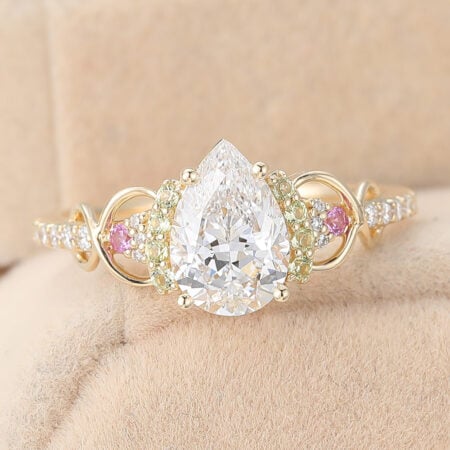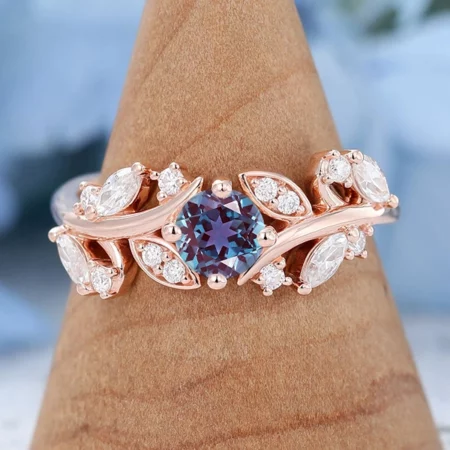Does 14k Gold Tarnish – What Can You Do About It?
‘Does 14k gold tarnish’ is a question that many jewelry lovers are concerned about. 14K gold is popular for its balanced composition and durability, but sometimes it darkens or loses its luster during wear. This article will explore the reasons why this change may occur, introduce practical methods to help you restore the luster of jewelry, and learn how to delay the tarnishing process of 14K gold jewelry in daily life.
What Is 14k Gold?
14K gold is an alloy with 58.5% pure gold, while the real 100% pure gold is 24k gold, which is also the origin of the number 14 in 14k gold, because 14/24 is 58.5%. The remaining 41.5% of the 100 components are composed of other metals, generally such as silver, copper, zinc or nickel. Compared with 18K or 24K gold, the metal ratio of 14k gold can greatly enhance the hardness and durability of the metal, so it is widely used in daily jewelry such as rings, necklaces, earrings, etc.
How much is 14k gold worth?
14K gold is an alloy containing 58.5% gold, so it is more affordable than 24k pure gold, but it still has a certain ability to maintain its value. This is one of the reasons why the price of 14k gold is relatively low but still popular, because it strikes a good balance between quality and cost performance. There are many factors that affect the 14k gold worth, including international gold price fluctuations, processing technology costs, and brand premiums. At present, the price of 14k gold is about $62 per gram, and the actual price will vary depending on the market, purchasing channels, and brands.
Does 14k Gold Tarnish?
Will the 14k gold that many consumers choose tarnish? Does its price match its quality?
Strictly speaking, 14k gold will tarnish, especially after being worn for a long period of time, the surface of 14k gold jewelry will become dark or black.
The luster of 14k gold is mainly related to its composition. Generally speaking, gold will not tarnish or fade, but the other components of 14k gold, silver and copper, are easily reacted with air, sweat and chemicals.
When the copper in 14k gold comes into contact with oxygen, sulfur, etc. in the air, it may produce dark red or brown-yellow color changes on the surface of the jewelry, and when silver and sulfur compounds in the air, dark gray or black spots will appear on the surface of 14k gold jewelry, causing 14k gold to lose its original luster. But don’t worry, these discolorations are usually surface phenomena and can be restored through proper cleaning and daily maintenance.

Why does gold tarnish?
Influence of alloy composition
14K gold is composed of 58.5% gold and 41.5% alloy metals, often containing copper, silver, etc, which is the main factor of the question”does 14k gold tarnish”. These alloy metals react chemically with air and moisture more easily than gold, causing the surface to gradually lose its luster and become dull.
Oxidation reaction
The copper and silver in the alloy will react with oxygen and moisture in the air to form a thin oxide film, which covers the metal surface, causing the color of 14K gold to gradually darken and the glossiness to be significantly reduced, affecting the appearance.
Sulfidation
The air often contains trace sulfides, which will react with the metal elements in the 14K gold alloy to form black-gray sulfide deposits, causing spots and dullness on the surface of the gold jewelry, which will seriously affect the overall brightness of the gold jewelry.
Friction and wear
Friction during wearing and daily use will produce fine scratches on the surface of 14K gold, destroying the smoothness of the metal surface. The accumulation of scratches will reduce the reflection effect of light, causing the gold jewelry to appear to lose its original bright luster.
Environmental factors
High humidity, human sweat, perfume and chemicals can accelerate the oxidation and discoloration of 14K gold. Especially in sulfur-containing environments, these factors are more likely to cause chemical reactions on the alloy surface, causing the gold jewelry tarnish and become dull.
How to Remove Tarnish from 14K Gold?
Wash with mild soapy water
Soak 14K gold jewelry in warm water mixed with neutral soap for 5-10 minutes, gently scrub the surface with a soft brush to remove attached stains and slight oxidation, then rinse with clean water, and dry to restore some of the luster.
Soda to remove oxidation
Mix soda and a small amount of water into a paste, apply it to the tarnished 14K gold jewelry, let it sit for a few minutes and wipe it with a soft cloth, which can effectively soften and remove the surface oxide layer, and then rinse it with clean water.
Soak in professional detergent
Use a detergent designed specifically for gold to soak 14K gold jewelry for several minutes. The chemical composition can dissolve oxides and help restore the luster. Rinse with water after use and wipe thoroughly with a soft cloth.
Quick recovery with polishing cloth
Repeatedly wipe the oxidized and discolored parts with a special polishing cloth or silver cloth to remove the oxide layer by friction, and quickly restore the original luster of 14K gold. It is suitable for gold jewelry with slight loss of gloss.
How to Prevent 14K Gold from Getting Tarnished?
Avoid contact with chemicals
In daily life, 14K gold jewelry should be kept away from chemicals such as perfume, detergent, chlorine water, etc. These ingredients will accelerate the oxidation of the metal surface and affect its gloss and color.
Take it off before activities
14K gold jewelry should be taken off when bathing, swimming, exercising or doing housework. Sweat and friction will cause the surface to lose its original gloss or even appear spots.
Regularly wipe and maintain
Gently wipe the surface of gold jewelry with a soft jewelry cloth regularly to effectively remove sweat stains and dust, prevent oxidation accumulation, and keep it as bright as new.
Seal and store jewelry
When not wearing, 14K gold jewelry should be stored separately in a sealed bag to avoid contact with air moisture and prevent scratches and dullness caused by friction with other metals.
Avoid high temperature and humidity
High temperature or humid environment will accelerate metal oxidation. When wearing 14K gold jewelry, try to avoid sauna or hot outdoor environment to prolong the gloss durability.


Conclusion
Knowing the answer to “does 14k gold tarnish” can help us put 14K gold jewelry in a correct perspective on its durability and maintenance needs. Although 14K gold may tarnish slightly over time due to its alloy composition, regular cleaning and proper storage can effectively delay its darkening process and keep it shiny for a long time. If you want to buy high-quality 14k gold jewelry, browse Amanda’s jewelry collection now.
FAQs About Does 14k Gold Tarnish
14k gold does not rust, but it can tarnish or darken slightly over time due to its alloy content. In rare cases, it may turn green on some skin types. It is relatively durable but can still scratch. With proper care, it can last a lifetime.
White gold, rose gold, and yellow gold can tarnish depending on their alloy composition. White gold often has a rhodium plating that prevents tarnish but may wear off over time. Rose and yellow gold contain alloys that can oxidize, causing slight discoloration, but solid gold itself does not tarnish easily.
The value of a 14k gold ring depends on its weight, craftsmanship, brand, and market gold price. On average, a 14k gold ring ranges from $150 to $500, based on a gold price of around $60–$65 per gram.
14k gold means the metal is 58.5% pure gold, mixed with other metals for strength. Yes, it is considered real gold and is a popular choice for everyday jewelry due to its balance of durability and value.
10k gold is more durable because it has a higher percentage of alloy metals, making 10k gold stronger than 14k. However, 14k offers a better balance between strength and gold purity, while 18k is richer in gold content but softer and more prone to scratches. The choice depends on your preference for durability versus purity.
14k gold jewelry holds value due to its gold content, making it a relatively stable investment. While not as pure as 24k, it offers better durability and resale potential, especially if well-crafted or from a reputable brand.
14k gold is generally hypoallergenic, but it may cause irritation in people sensitive to nickel if present in the alloy. It is not magnetic, as pure gold and its typical alloy metals are non-magnetic.
Yes, you can wear 14k gold in the shower occasionally, as it can get wet without immediate damage. However, frequent exposure to water and soap may dull its shine over time.
Solid gold jewelry, especially 18k and 24k, doesn’t tarnish easily due to its high gold content. Real solid gold doesn’t tarnish. Plated, dipped, and plated brass can tarnish over time. Gold-filled is more resistant but may still tarnish with wear.
